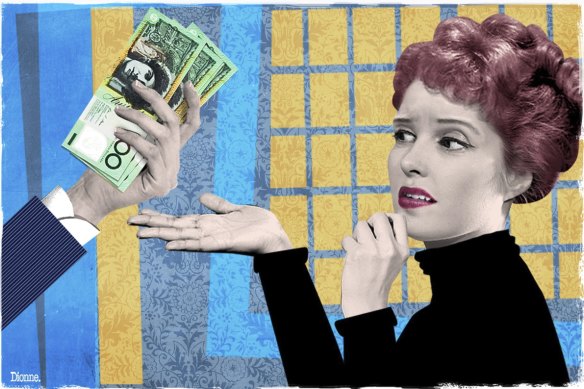Bigger pay rises likely from Labor’s new laws, but don’t spend them yet

Households hoping for instant cost-of-living relief from Labor’s new industrial relations legislation, now set to become law, will be sorely disappointed. If you listen to business lobby groups, of course, we’re all about to get pay increases so big they will bankrupt many businesses. But truth is often the first casualty on the complex battlefield between unions and employer groups on which the wages of most Australians are set.
Labor, of course, is adamant the laws as drafted will help revive flagging wages growth. In particularly, it hopes to strengthen the negotiating arm of workers – particularly low-wage workers – by making it easier for them to band together across multiple employers in one sector to push for bigger pay increases.
Illustration: Dionne GainCredit:
Of course, in a perfectly competitive world, the price of labour (wages) would be determined by the simple balance between the demand for labour and the supply of it. Employers would, in every case, pay a wage that perfectly reflected any particular individual worker’s unique productive capacity and which also compensated them for any increase in the general cost of living.
In such a perfect world, bosses would never discriminate, never try to inflate their bonuses by screwing costs down and never fail to pass on productivity gains made by workers. In reality, of course, workers have historically found it to their advantage to band together via unions to push for pay increases.
Which is not to say the forces of supply and demand are irrelevant in the labour market. Far from it. Good luck getting a big pay rise when unemployment is high. But nor does the labour market always reflect the perfectly competitive one that economists might hope for. In recent decades, in particular, it is clear that employers have emerged holding the upper hand in negotiations.
“Workers are receiving a smaller share of productivity growth than they did before,” observes Jeff Borland, a labour economist and professor at the University of Melbourne.
“The gap between real wages and productivity growth, if you look over the last decade, is as big as it has been since the early 1990s when, through the Accord, wages were deliberately held down. The reason for low wages growth is not just lower productivity growth, but workers receiving a smaller share of productivity gains, and that’s got to be to do with lower bargaining power.”
As a symptom, wages growth has been very slow to accelerate post-pandemic, despite the jobless rate falling to a half-century low, Borland says. Now, academics fiercely debate the exact reasons for this erosion of worker bargaining power. Is it competition from lower-cost workers abroad? The rise of labour replacing technologies? The rise of “superstar” firms in industries dominated by fewer players? Is it the decline in union membership?
Likely, it’s all of them. But industrial relations settings – the rules of the game that determine how employers and employees come together to determine the price of labour – are also a key part of the story.
Beginning with the Hawke government’s Accord, the direction of public policymaking in Australia over the past few decades has been to shift power away from unions and limit wage increases.
There is likely to be an upside for some lower-paid workers following Labor’s new laws.Credit:James Davies
The Howard government’s championing of individual contracts versus collective agreements accelerated the trend. Howard’s unpopular WorkChoices regime was largely unwound by the Rudd and Gillard governments, of course. But little has been done in recent decades to seriously attempt to shift power back into the hands of workers.
Until now.
Only time will tell if Labor’s legislation, as drafted, delivers unions the power they need to push for bigger and multi-employer pay rises. Large concessions have been made. Smaller businesses with fewer than 20 staff will be exempt. Employers with up to 50 employees will have special provisions to wriggle out.
It’s true employees of larger firms in low-paid industries, such as aged care and childcare, will get new powers to go on strike for better pay and conditions. But it remains to be seen if unionisation rates remain high enough in those industries to take up the cudgels of collective strike action.
When they do, it’s important to remember the employer in such cases is often the government itself, so any resulting higher wages bills will be paid for by taxpayers.
Whether multi-employer agreements are taken up across the wider economy, among retail and hospitality workers or other services industries for instance, remains to be seen. The civil construction sector has been expressly excluded.
Borland says it’s too early to quantify what effect Labor’s laws will have on wages, but suspects the direction will be upwards. “I think that’s the most plausible interpretation, but it’s so hard to say. No one should be thinking that they’re going to get a pay rise before Christmas.”
One thing is clear, however, Borland says, and that is the new laws do not, as some scaremongers argue, take Australia back to the 1970s and “pattern bargaining”, in which wage gains in one industry flow quickly into other industries through noisy demands for “comparative wage justice”.
Unionisation rates remain starkly lower than in the 1970s and the Fair Work Commission will hold significant sway in how it gives effect to the new laws.
The bottom line: there is likely to be an upside for some lower-paid workers in Labor’s new laws, but I wouldn’t bank that pay rise just yet.
The Opinion newsletter is a weekly wrap of views that will challenge, champion and inform your own. Sign up here.
More from our award-winning columnists
An anxious nation: Mortgage stress, COVID burnout, extreme weather and the cost of living crisis – no wonder Australia’s status as the “lifestyle superpower of the world” is under threat – Nick Bryant
The future of democracy: Australia must learn from America’s descent into extreme inequality, which has led to deep discontent. It must also do more to civilise “social” media – the great amplifier of hate – Peter Hartcher
Behind the interview: Shane Warne may have been the greatest bowler legendary interviewer and cricket lover Michael Parkinson has ever seen, but he’s not his favourite interview – Peter FitzSimons
Most Viewed in Business
From our partners
Source: Read Full Article


